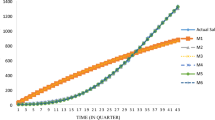Abstract
Recent studies of innovation diffusion have investigated cross-country heterogeneity, but implicitly assumed within-country homogeneity. As such, these studies potentially overlook within-country variations in diffusion patterns, which may be even more important to marketing managers and researchers alike. The current paper is concerned with such intra-country variations using one of many possible a priori segmentation schemes, namely geographic segmentation. It empirically demonstrates that when substantial regional variations in diffusion patterns occur, taking account of these regional differences improves both short- and long-term forecasting under certain conditions. Regional differences in diffusion patterns also provide some important normative implications.
Similar content being viewed by others
5. References
Bass, F.M. (1969). “A New Product Growth Model for Consumer Durables,” Management Science 15(5) (January), 215–227.
Bass, F.M., T.V. Krishnan and D.C. Jain. (1994). “Why the Bass Model Fits Without Decision Variables,” Marketing Science 13(3) (Summer), 203–223.
Gore, A.P. and U.A. Lavaraj. (1987). “Innovation Diffusion in a Heterogeneous Population,” Technological Forecasting and Social Change 32, 163–168.
Horsky, D. and L.S. Simon. (1983). “Advertising and the Diffusion of New Products,” Marketing Science 2(1) (Winter), 1–17.
Jain, D.C. and R.C. Rao. (1990). “Effect of Price on the Demand for Durables: Modeling, Estimation and Findings,” Journal of Business & Economic Statistics 8(2) (April), 163–170.
Kalish, S. (1983). “Monopolist Pricing with Dynamic Demand and Production Cost,” Marketing Science 2(2) (Spring), 135–159.
Kamakura, W.A. and S.K. Balasubramanian. (1988). “Long-Term View of the Diffusion of Durables: A Study of the Role of Price and Adoption Influence Processes Via Tests of Nested Models,” International Journal of Research in Marketing 5, 1–13.
Lilien, G.L., A.G. Rao, and S. Kalish. (1981). “Bayesian Estimation and Control of Detailing Effort in a Repeat Purchase Diffusion Environment,” Management Science 27(5) (May), 493–506.
Mahajan, V., E. Muller and F.M. Bass. (1993). “New Product Diffusion Models,” In J. Eliashberg and G.L. Lilien (eds.), Handbooks in Operations Research & Management Science, Vol. 5: Marketing (349–408). Amsterdam: North-Holland.
Mahajan, V. and R.A. Peterson. (1979). “Integrating Time and Space in Technological Substitution Models,” Technological Forecasting and Social Change 14, 231–241.
Norton, J.A. and F.M. Bass. (1987). “A Diffusion Theory Model of Adoption and Substitution for Successive Generations of High-Technology Products,” Management Science 33(9) (September), 1069–1086.
Parker, P.M. (1994). “Aggregate Diffusion Forecasting Models in Marketing: A Critical Review,” International Journal of Forecasting 10, 353–380.
Robinson, B. and C. Lakhani. (1975). “Dynamic Price Models for New Product Planning,” Management Science 10 (June), 1113–1122.
Rogers, E.M. (1995). Diffusion of Innovations (4th ed.). New York: The Free Press.
Srinivasan, V., and C.H. Mason. (1986). “Nonlinear Least Squares Estimation of New Product Diffusion Models,” Marketing Science 5, 169–178.
Weerahandi, S. and S.R. Dalal. (1992). “A Choice-Based Approach to the Diffusion of a Service: Forecasting Fax Penetration by Market Segments,” Marketing Science 11(1) (Winter), 39–53.
Author information
Authors and Affiliations
Rights and permissions
About this article
Cite this article
Steffens, P. Applying Diffusion Models with Regional Heterogeneity. Marketing Letters 9, 361–369 (1998). https://doi.org/10.1023/A:1008041517592
Issue Date:
DOI: https://doi.org/10.1023/A:1008041517592




